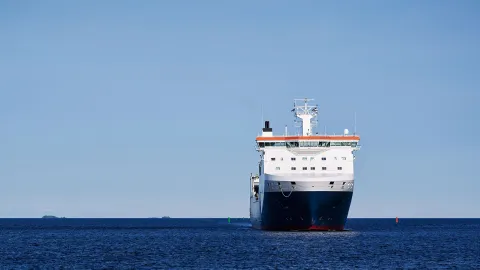Environmental and social risk management process identifies projects with major impacts and high risks

Application forms for export credit guarantees were updated in early 2021, and they now contain questions about the use and location of the export product as well as its potential environmental and social impacts and risks.
Published date
Since the beginning of 2021, all applications for Finnvera’s export financing have been screened for environmental and social risks. In 2021, 455 examinations were carried out. By managing the environmental, social and governance risks, or ESG risks for short, Finnvera ensures compliance with corporate responsibility in its financing. Careful assessment of the projects to be funded is part of Finnvera’s risk management.
Our application forms for export credit guarantees were updated in early 2021, and they now contain questions about the use and location of the export product as well as its potential environmental and social impacts and risks. These questions are used to map the ecological values of the project site and determine if the investment could have impacts on the people living in the area, especially any vulnerable groups.
Environmental and social risk management process updated in 2021
Finnvera identifies projects which may have major environmental and social impacts and high risks based on export credit guarantee applications and other potential information sources.
The themes of the risk assessment include the reputation of the export product’s end user, the human rights and political situation in the country, the environmental and social risks inherent in the combination of the country and sector, and environmental factors of the site, including the proximity of nature conservation areas or areas used by indigenous peoples. Indicators have been defined for different themes, based on which the application is assigned to risk category (A/B/C) defined by Finnvera. These indicators represent internationally renowned, reliable sources that seek to provide objective information on such aspects as the country’s human rights situation.
If the risks associated with the sector are high and the target country’s legislation related to environmental and social risks is weak or its enforcement is lacking, Finnvera has a more stringent obligation to ensure that national and international requirements are met. Finnvera’s possibilities of influencing the environmental and social factors of theproject also play a role in risk management and the financing decision. The State of Finland as Finnvera’s owner has instructed Finnvera to give more weight to the United Nations Guiding Principles on Business and Human Rights (UNGPs) when assessing financing projects.
An application related to an investment that may involve significant negative environmental or social impacts or risks, including human rights risks, is placed in risk category A. The impacts may be permanent or complex, or extend beyond the location of the project. In risk category B, the impacts are smaller and easier to manage, local and largely reversible. Even in risk category B, higher-risk projects are assessed more thoroughly. Applications in risk category C are not associated with negative environmental and social impacts, or these impacts are minor. Consequently, no ES assessment is needed for an application placed in risk category C.
Assessment of export projects in 2021
Finnvera received 455 applications in 2021, of which 309 were screened for environmental and social risks. Of these, 42% were placed directly in risk category C. For letters of credit and bank risk guarantees with a payment period of less than two years, an ex post evaluation of the environmental and social risks is carried out annually. The number of these guarantees was 113. Applications that were not automatically placed in risk category C or which were not covered by ex post evaluations were processed by experts of environmental and social risks. The number of such applications was 180, and 37% of them were initially placed in risk category A, 26% in risk category B, and 34% in risk category C. Large projects accounted for 35 of these applications.
In its assessments, Finnvera works closely together with various stakeholders, including other export credit agencies, export companies, buyers, and banks. In large category A projects, which include pulp mills, mines or power plants, the processing time is typically months or even years. In 2021, the largest assessed projects were located in Brazil, Chile and China.
In discussions with the parties of the export transaction, the environmental and social criteria necessary for the realisation of the transaction are always reviewed. The aim is to be proactive and to guide, ensuring that the transaction can meet the financing decision requirements. This is not always the case, however. One financing application was turned down in 2021 because of its social and environmental risks. The reasons for this were extremely serious shortcomings in managing the project’s environmental and social risks and the operator’s bad reputation.
Important site visits were not possible during the pandemic
After the application and screening stage of large risk projects, a due diligence consultant visits the site of the transaction to be financed and prepares an Environmental and Social Due Diligence (ESDD) report. The report assesses if the project meets the requirements of the World Bank Group’s Environmental, Health, and Safety Guidelines and the IFC Environmental and Social Performance Standards as well as the preconditions of Finnvera’s ES risk management policy. In addition, it lists the measures that must be taken to meet these requirements.
In some cases, a site visit by a Finnvera expert is also desirable. On such visits, the operator’s attitude, ability and practices related to risk management are assessed. In addition, we listen to the opinions of various stakeholders in the area affected by the project, including NGOs, authorities and people, to get a comprehensive overview of the project and to understand local circumstances.
The pandemic continued to make site visits impossible in 2021. In some cases, site visits were organised virtually using remote connections and drone cameras. Finnvera plans to visit the sites of high-risk projects as soon as the situation permits. In credit agreements, an effort has beenmade to ensure that Finnvera gets sufficient access rights to the project area.
If the project also meets the requirements for managing environmental and social risks, the financing decision may be approved. A monitoring plan for the project will then be produced. In transactions with particularly high risks, a consultant monitors the activities throughout the loan repayment period. If problems emerge, the primary means to address them is negotiations.
More detailed tax haven and tax avoidance prevention policy
The “Know Your Customer” (KYC) process is an essential part of processing financing applications. It includes registering the clients’ identifying data and information on the company’s ownership structure, the nature of its business and the object of financing. Applicants are also required to provide information on beneficial owners and so-called PEP information, which indicates if the beneficiary of the client enterprise is a politically exposed person. The background screening also extends to the export company’s buyer client and, if necessary, to other parties in the project to be financed in most export financing products.
Finnvera’s operating policies are reviewed and updated annually. In 2021, detail was added to the Tax haven and tax avoidance prevention policy to ensure its compliance with the requirements of identifying and preventing tax avoidance, which must be met in order to access EU financing. When channelling EU funds, Finnvera cannot grant financing to a company if its ownership is even partly in a tax haven blacklisted by the EU.
The assessment and management of impacts and risks in Finnvera’s export credit guarantee projects exceed the minimum level of the OECD Common Approaches, which concern export guarantees with a repayment period of over two years.
Additional information:
Take a look of a more detailed description of Finnvera's ES risk management process
ESG risk management in financing operations in Finnvera's Annual Review (PDF)



